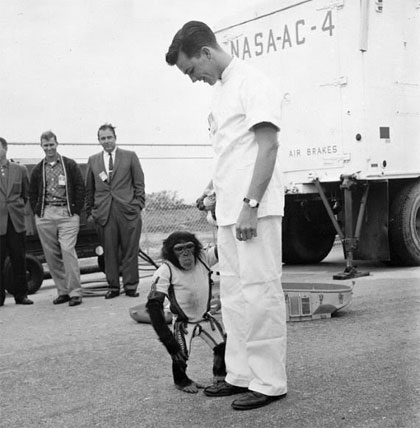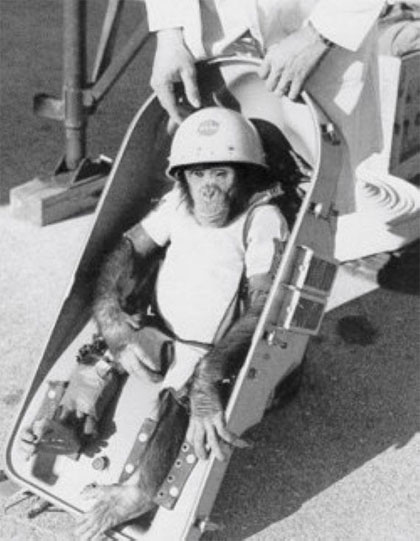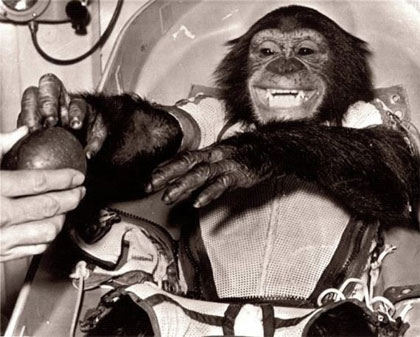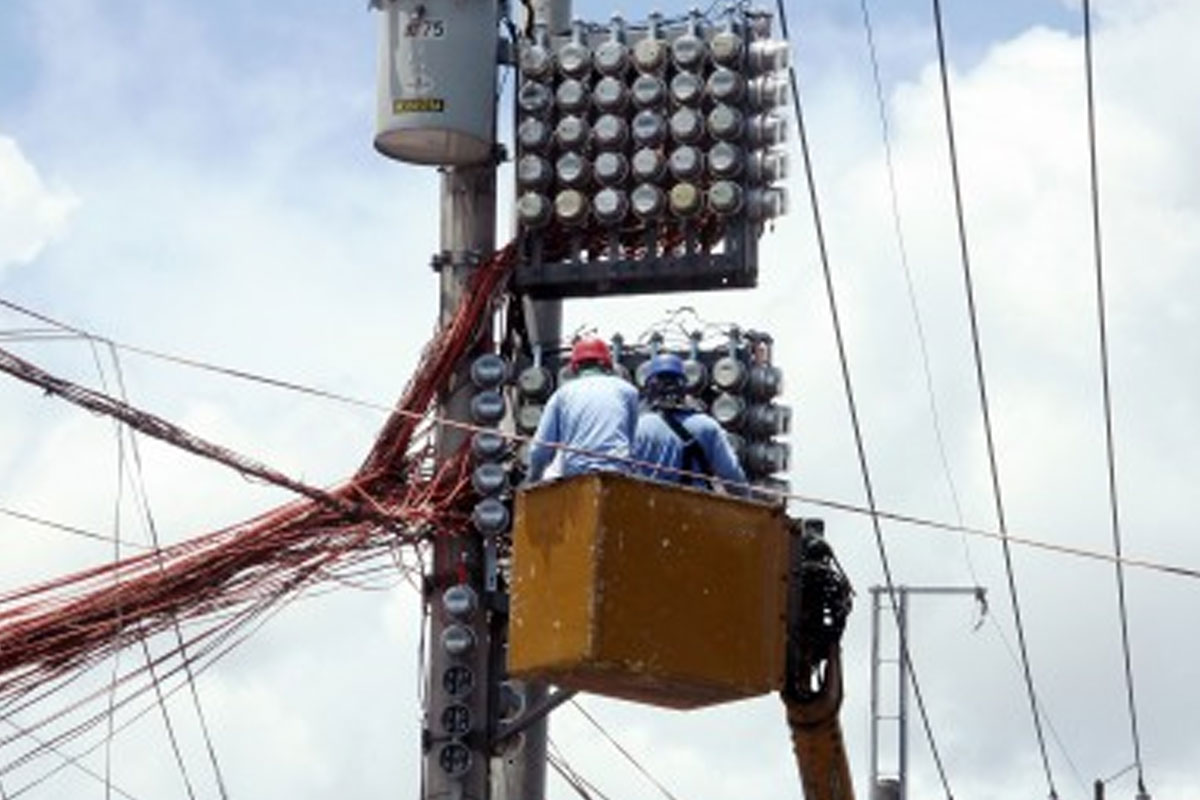
The Strange Story of Ham, the Space Chimp
Brent Swancer July 8, 2021
In the annals of our journey towards space exploration and penetrating out into the stars there have been many milestones. The first man in space, the landing on the moon, and others, they have all served to mark our progress from our heritage as mere apes to our place out among the universe using the most advanced technology possible. There has been much said about the human pioneers of space travel and what they accomplished, but what if one of the real pioneers was an actual ape? This is actually the case, and rather than a human being, one of the first real travelers out into the cosmos was a chimp named Ham.
The chimpanzee who would later be known as Ham started his life like any other wild chimpanzee. Born free in July of 1957 in a rainforest in the Central African nation of French Cameroon, now Cameroon, he lived a rather normal life until one day he was captured by illegal trappers when he was still very young, and later somehow ended up at the Rare Bird Farm in Miami, Florida, far from home and separated from his family. It was here where in 1959 he would attract the attention of the United States Air Force, who would purchase him from the bird farm and then whisk him off to Holloman Air Force Base, in New Mexico. However, the young, scared chimpanzee was not going to be their mascot or a mere curiosity, but rather the United States wanted to train him to fly to space.
 At the time, the space race between the United States and the Soviet Union was in full swing, with each side constantly one-upping the other and the ultimate goal to send the first human into space. In this era, our knowledge of the effects of what being in orbit would do to us was limited, and it still wasn’t fully understood what being in space would do to the human body, so there had been much experimentation with using animals to send up and see what happened. Dogs, monkeys, mice, a rabbit, and even fruit flies had all been used, many of them not surviving the journey, but this time the U.S. was looking to try something different. They wanted to actually train a chimpanzee to operate a modified spacecraft on its own, and to this end they had organized an actual astronaut school for chimps at Holloman Air Force Base. Chimpanzees were seen as ideal candidates because they so closely resembled human beings in so many ways, including physiology, intelligence, and manual dexterity, and NASA’s publication This New Ocean: A History of Project Mercury would explain of the desirability of using chimps as astronauts:
At the time, the space race between the United States and the Soviet Union was in full swing, with each side constantly one-upping the other and the ultimate goal to send the first human into space. In this era, our knowledge of the effects of what being in orbit would do to us was limited, and it still wasn’t fully understood what being in space would do to the human body, so there had been much experimentation with using animals to send up and see what happened. Dogs, monkeys, mice, a rabbit, and even fruit flies had all been used, many of them not surviving the journey, but this time the U.S. was looking to try something different. They wanted to actually train a chimpanzee to operate a modified spacecraft on its own, and to this end they had organized an actual astronaut school for chimps at Holloman Air Force Base. Chimpanzees were seen as ideal candidates because they so closely resembled human beings in so many ways, including physiology, intelligence, and manual dexterity, and NASA’s publication This New Ocean: A History of Project Mercury would explain of the desirability of using chimps as astronauts:
Intelligent and normally docile, the chimpanzee is a primate of sufficient size and sapience to provide a reasonable facsimile of human behavior. Its average response time to a given physical stimulus is .7 of a second, compared with man’s average .5 second. Having the same organ placement and internal suspension as man, plus a long medical research background, the chimpanzee chosen to ride the Redstone and perform a lever-pulling chore throughout the mission should not only test out the life-support systems but prove that levers could be pulled during launch, weightlessness, and reentry.
Forty chimpanzees had been chosen for the elite program, and one of these was our little friend from Cameroon, at the time merely referred to as “No. 65,” because it was more impersonal and the government did not want to risk the bad publicity that could come from a named chimp dying during a mission. The chimpanzee candidates underwent 2 years of various types of intense training at the Holloman Air Force Base Aero Medical Field Laboratory, learning how to pull levers, turn knobs, and do a number of other simple tasks in response to electric lights and sounds. To do this, a simple reward system was used. If the chimp was successful in its task it received a food pellet, but if it failed it would receive a light electric shock to the soles of its feet. In addition, the animals were exposed to simulated G-forces and microgravity, as well as receive training on how to sit calmly in the space capsule that would be used to take them to space. Through all of this training some chimps fared better than others, and the number of animals was pared down from forty to eighteen, and then later to just six. At the top of the class was No. 65, who not only showed an incredible aptitude for performing his various duties and tasks correctly, but was an amazingly fast learner, and was additionally remarkably tame, gentle, and easy to handle. He outshone the others and was soon considered the favorite for any potential mission.
 In the end, the six finalists were prepped to perform an actual mission, which was to be a suborbital flight on the Mercury-Redstone 2 mission, part of the U.S. space program’s Project Mercury. On January 31, 1961, they were flown to Cape Canaveral, Florida, where they underwent various physical examinations and finally be whittled down to just one chimp. That one would be No. 65, due to his good spirits and energy even after the long trip and all of the poking and prodding, saving one other chimp as a backup, a female by the name of Minnie. No. 65 would then be strapped into a harness inside a specially modified space capsule, hooked up to various sensors to monitor his vital signs during the mission, put into the nosecone of the Mercury-Redstone 2 rocket, and launched out into space to meet his destiny and make history. During the 16.5-minute flight, No. 65 performed admirably in zero gravity, performing the lever pulling and other tasks quickly and with an almost 100% success rate, but things didn’t all go smoothly. During the mission, the capsule suddenly experienced a partial loss of air pressure, with the chimp only surviving because of his spacesuit, and there were other technical glitches and issues as well, which made the flight much more taxing on the body than originally planned, and not only that, but the capsule would come down way off course. NASA’s A Brief History of Animals in Space says of these various issues:
In the end, the six finalists were prepped to perform an actual mission, which was to be a suborbital flight on the Mercury-Redstone 2 mission, part of the U.S. space program’s Project Mercury. On January 31, 1961, they were flown to Cape Canaveral, Florida, where they underwent various physical examinations and finally be whittled down to just one chimp. That one would be No. 65, due to his good spirits and energy even after the long trip and all of the poking and prodding, saving one other chimp as a backup, a female by the name of Minnie. No. 65 would then be strapped into a harness inside a specially modified space capsule, hooked up to various sensors to monitor his vital signs during the mission, put into the nosecone of the Mercury-Redstone 2 rocket, and launched out into space to meet his destiny and make history. During the 16.5-minute flight, No. 65 performed admirably in zero gravity, performing the lever pulling and other tasks quickly and with an almost 100% success rate, but things didn’t all go smoothly. During the mission, the capsule suddenly experienced a partial loss of air pressure, with the chimp only surviving because of his spacesuit, and there were other technical glitches and issues as well, which made the flight much more taxing on the body than originally planned, and not only that, but the capsule would come down way off course. NASA’s A Brief History of Animals in Space says of these various issues:
The original flight plan called for an altitude of 115 miles and speeds ranging up to 4,400 mph. However, due to technical problems, the spacecraft carrying Ham reached an altitude of 157 miles and a speed of 5,857 mph and landed 422 miles downrange rather than the anticipated 290 miles… He experienced a total of 6.6 minutes of weightlessness during a 16.5-minute flight.
Even when the capsule made it down to the Atlantic Ocean in one piece there were problems, when No. 65’s capsule began to take on water and flood, threatening to drown him. Fortunately, the helicopter from the USS Donner was able to reach him before he perished. In the end, No. 65 had made it through his ordeal in remarkably good condition, suffering no more than a bruised nose. A full examination would show that he was slightly fatigued and dehydrated, but otherwise in good health, and in the meantime he had become an instant celebrity, graduating from No. 65 to a real name, being called “Ham,” which stands for Holloman Air Force Medical. The suddenly popular Ham was all over the news, and immediately put through a publicity campaign that made him out to be a hero and splashed his face across newspapers and magazine covers nationwide, as well as on TV, but there were others who questioned whether he was a valiant hero or a tragic victim.
 Not only had Ham been subjected to electric shocks for his training, but he had never consented to any of this, forced to go into space by a government who were not even entirely sure of what would happen to him up there. Biometric readings during the flight also showed that he had suffered extreme stress during acceleration and deceleration, although he had been calm in zero gravity. Can it be considered brave and heroic if one is forced to go through with something they may not want to do? Worst of all, although newspaper photos showing Ham in orbit and coming out of his capsule showed him “smiling” as if a proud hero, something that was played up by the press, this was sadly anything but. This “grinning” was actually a grimace of fear that chimps exhibit that only superficially appears to be a smile to us, and upon seeing the photos and footage of Ham recorded during his sixteen-minute flight, famed primatologist Jane Goodall would remark “I have never seen such terror on a chimp’s face.” Ham also showed great agitation and stress behavior whenever he was swarmed by the press, surrounded by crowds of people and camera flashes that must have been terrifying for him. There were also some instances of Ham snapping at reporters in agitation, and on one occasion when the press wanted a photo of him sitting in the capsule, he staunchly refused to go in, and physically resisted being put into it. Rather than a heroic milestone, for many this was all a great act of cruelty.
Not only had Ham been subjected to electric shocks for his training, but he had never consented to any of this, forced to go into space by a government who were not even entirely sure of what would happen to him up there. Biometric readings during the flight also showed that he had suffered extreme stress during acceleration and deceleration, although he had been calm in zero gravity. Can it be considered brave and heroic if one is forced to go through with something they may not want to do? Worst of all, although newspaper photos showing Ham in orbit and coming out of his capsule showed him “smiling” as if a proud hero, something that was played up by the press, this was sadly anything but. This “grinning” was actually a grimace of fear that chimps exhibit that only superficially appears to be a smile to us, and upon seeing the photos and footage of Ham recorded during his sixteen-minute flight, famed primatologist Jane Goodall would remark “I have never seen such terror on a chimp’s face.” Ham also showed great agitation and stress behavior whenever he was swarmed by the press, surrounded by crowds of people and camera flashes that must have been terrifying for him. There were also some instances of Ham snapping at reporters in agitation, and on one occasion when the press wanted a photo of him sitting in the capsule, he staunchly refused to go in, and physically resisted being put into it. Rather than a heroic milestone, for many this was all a great act of cruelty.
Whether Ham was a hero or victim, he was the first primate to go to space, his historic flight beating out the first man to space, the Soviet Yuri Gagarin on April 12, 1961, as well as the May 5, 1961 mission of the first American in space, Alan Shepard. The mission had also proven that humans could survive and perform complex tasks in zero gravity, and as far as the government was concerned, Ham’s mission had been a massive success. NASA would send another chimp by the name of Enos up into orbit on November 29, 1961, but after that the “astrochimp” program was discontinued. Ham went on to the National Zoo in Washington, D.C. where he lived in solitude for 17 years, after which he was transferred to the North Carolina Zoological Park in Asheboro, North Carolina to live out the rest of his days with a group of other chimps. Ham passed away on January 19, 1983 at the age of 26, and his body was given to the Armed Forces Institute of Pathology for necropsy, after which the plan was to have him stuffed and put on display at the Smithsonian Institution, but public outrage against this caused the plan to fall through. In the end, Ham’s skeleton would be kept in the collection of the National Museum of Health and Medicine, while the rest of his remains were given a burial and memorial service at the International Space Hall of Fame in Alamogordo, New Mexico. It is a rather sad end to an unspoken pioneer of space travel, and a talking point on the ethics involved in all of this. Hero or victim, Ham helped pave the way for space exploration as we know it, and it remains a curious and rather bizarre chapter in our efforts to reach the stars.
MU*



















